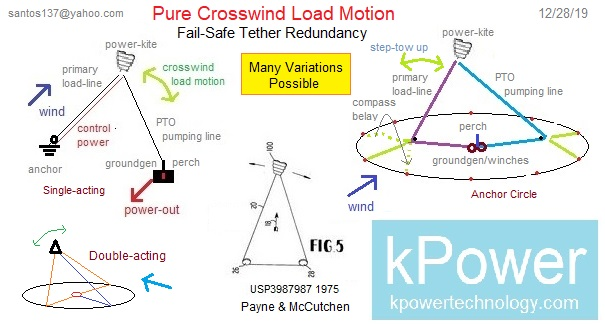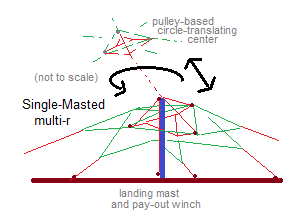Multi-r
AWES and Gravity-Drive
Mars Colonization Energy Solution
Mars Colonization Energy Solution
Send
AWE notes and topic replies to editor@upperwindpower.com
August 3, 2020, post by Dave Santos [post is also in topic SkySails]
Pure Crosswind Load Motion
Had KiteShip continued R&D, they would likely be doing multi-MW scale output, but with less all-mode automation. The calculation was 2MW per person, as a rough labor standard in COTS power plants, and that FAA would in any case require a PIC (Pilot-in Command) for sense-and-avoid. NASA LaRC's NI based vision system (Austin) would have been the supervisory automation basis.
Expect SkySails to converge toward larger SS wings, consistent with Culp's findings and TUDelft's upcoming MSc Thesis. As a minimal surface with unbeatable scalability, the OL could be licensed, or an SS open-source NPW variant adopted.
The topological design variants below offer operational advantages over the SkySails initial reeling architecture: more continuous power cycle, no downwind cycle loss, no control-pod nor conductive tether dependence, and far less runaway risk (passive self-kill). Not all the details are clear in this schematic, like kPower's basic method for multi-line control, via heddle pulleys.

The
current best-design-concept seems to be the steepest possible ropeway
loop, with gens top and bottom, and just two counter-balanced mass-cars
that alternate in up-down travel. Its not quite a continuous cycle, but
quite simple, with the least gear-mass to bring to Mars. Early versions
of 5k vertical seem right, with up to 30k vertical max.
To: help@sti.nasa.gov <help@sti.nasa.gov>
Sent: Saturday, August 1, 2020, 09:43:24 AM CDT
Subject: Request for Evaluation of Alternative Mars Colonization Energy Concept- Gravity Ropeways
Dear NASA STI,
Seeking
closest institutional matches in Mars Colonization and Planetary
Science research community for starting evaluation of using
gravitational potential energy of terrain mass in various possible
combinations of extraction, storage, and hybrid use. Mars has the
greatest vertical terrain distances of any planet (~30km) and
considerable gravity (~40% of Earth G). Gravity-driven ropeways or
vehicles with regenerative capability could provide abundant energy
on-demand.
The concept
seems to promise strong theoretic advantages over every other option,
but does not yet seem on anyone's list of Martian engineering options.
Proposing initial STI Technical Memorandum be drafted in collaboration
with NASA and pertinent academic and private-sector experts. Detailed
preliminary notes and calculations available in active early
preparation.
Thanks for STI identifying starting contacts for this, perhaps at NASA LaRC or JPL.
Best,
Dave Santos
Austin
Joe Faust
Los Angeles
kPower
[sent image]
Multi-r single-mast launching and landing solution
Single center mast precludes:
- peripheral suspension from multi-r legs,
- operation from grass field

Solution suited for single-hill/mountain use.
Mars colonization links
It
seems that gravity-drive regen and suspended AWE have not previously
been part of Mars Colonization planning, but energy scarcity has been
one of the most glaring engineering gaps. Links below.
Looking
next for SpaceX internal planning, which surely exists in very
preliminary form, but Tesla/Musk has plentiful cash to move R&D
forward even if current space-launch revenue is marginal. This could be
a multi-r R&D angle, even though flying domes and mountain-masted
variants are not exactly the same thing, but they are related and
visually quite similar. Tesla has recently chosen Austin as its prime
expansion location, and South Texas is the Mars launch-site choice,
with the space base slowly taking shape.
Multi-r AWES and Gravity-Drive Mars Colonization Energy Solution
Alternative
Mars-Colonization Energy Concept- Highest Density, Availability, and
Abundance
TUDelft
recently completed a student design challenge that included an AWES
concept to support Mars colonization. Seasonal energy storage was found
essential to bridge marginal power and high intermittency of Martian
kite and solar inputs alone.
An
alternative energy generation and storage approach to Martian
colonization is to roll electrical-regenerating geomass-carriers
down-slope across huge vertical gradients (~30km) like Olympus Mons, or
the rim of Valles Marineris (~10km). The associated excavations and
spoils can be used to create radiation-shielded habitable mine shafts
and artificial caverns. In principle, there could be abundant
high-power available, on-demand, by such a gravity-drive.
Gravitational
potential energy extraction by itself is not permanently sustainable on
Mars, but could effectively catalyze large-scale colonization and even
terra-forming. For a perpetually sustainable
cycle, Olympus Mons, again as a prime example, could be rigged as a
multi-r AWES "mast" with radiating kite-driven/mass-driven cableways.
Mass storage sent downhill on-demand to power colonization during calm
could be returned uphill during wind events, in a sustainable energy
cycle.
This
may be the most viable energy-tech approach to making Mars a "second
Earth".

